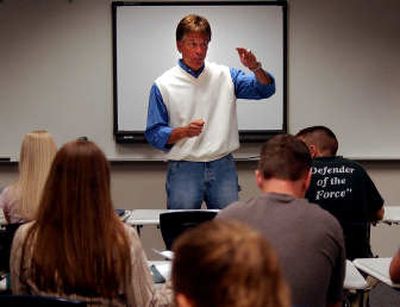Learning Holocaust’s lessons

In 1986, Central Valley High School teacher Steve Bernard took a group of teenagers on a tour through a Nazi concentration camp.
He never expected that what he saw would become his life’s work.
As he led the 50 students into one of the only remaining gas chambers in Auschwitz, which were used for mass murders, he witnessed the impact that just standing in the dank room had on the young people with him.
He watched their faces contort with horror as they walked into one of the barracks at the camp, and passed a 6-foot pile of human hair used to line the boots of Nazi soldiers.
“I’ll never forget it,” Bernard said.
Now a Holocaust teacher at CV, Bernard is making sure the current generation of teens doesn’t forget the atrocities of Nazi Germany, either.
Largely because of his passion for the subject, Bernard was awarded a Museum Teacher Fellowship at the United States Holocaust Memorial Museum in Washington, D.C., this summer.
It will be a week of intense study, which includes an interview with a survivor. The prestigious fellowship is given to 15 teachers a year nationwide.
“I thought I had about as much luck of getting the fellowship as winning a lottery ticket,” Bernard said. “I’m humbled and excited for the opportunity to come back with more knowledge.”
After his trip to Auschwitz in the 1980s, Bernard, who has been a teacher for 29 years, knew he wanted to teach students about Nazi history and the Holocaust.
He spent hundreds of hours developing the curriculum for the Holocaust course at CV, which has been a stand-alone class taught by Bernard for at least 15 years.
More than 200 students enroll in Bernard’s classes each year, with four or five sections each semester that are almost always full.
Bernard uses technology and visual aids in the course to take students on a journey through the horrible events of the past.
Students tie in the haunting images with literature, using the lone textbook for the class, an unpublished manuscript of an elderly woman who survived one of the six German death camps in eastern Poland.
While the class focuses on German history and the events of the Holocaust, the underlying message is about the effects of hate. Students use the Holocaust to talk about current atrocities, such as the genocide in Darfur, Sudan.
“It’s a very popular course with our students,” said CV Assistant Principal Evan Sorenson. “I think it creates a tremendous opportunity for the kids to understand, not just from a historical perspective, but on the issues surrounding hate and prejudice … and the dramatic implications that can have for everybody.”
The fellowship will be Bernard’s second trip to the 265,000-square-foot national museum. He’ll be able to use the facility’s complete historical resources to further develop the curriculum for his classes.
“They are not just being lectured to. There is a lot of time for the teachers to study in depth, and to talk to each other about what they have learned,” said Miriam Greenbaum, who works for the Washington State Holocaust Education Resource Center.
Greenbaum said her organization uses teachers like Bernard, who have extensive training at places like the national museum, to teach local seminars about the Holocaust.
“It’s really an incredible opportunity to be in the museum that has the most incredible archives and articles to use, and to learn more about how we teach about the past using those historical archives,” she said.
As part of his application process, Bernard committed to creating an educational compact disc for teachers to use in the classroom and to offering adult classes.
“I want to encourage parents of the students taking the class to come and take it, too,” Bernard said.
“This isn’t just something that happened over 50 years ago – genocide is happening all over the world today,” Bernard said. “There is hatred and prejudice in our society, and we have to be strong enough to stand up against it.”